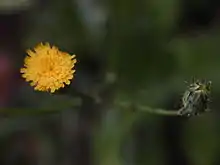| Hypochaeris chillensis | |
|---|---|
 | |
 | |
| Scientific classification | |
| Kingdom: | Plantae |
| Clade: | Tracheophytes |
| Clade: | Angiosperms |
| Clade: | Eudicots |
| Clade: | Asterids |
| Order: | Asterales |
| Family: | Asteraceae |
| Genus: | Hypochaeris |
| Species: | H. chillensis |
| Binomial name | |
| Hypochaeris chillensis | |
| Synonyms[1][2][3] | |
|
Synonymy
| |
Hypochaeris chillensis (sometimes spelled Hypochoeris) also known as Brazilian cat's ear is a species of flowering plant in the family Asteraceae. It is native to South America (Argentina, Bolivia, Chile, Paraguay, Brazil, Uruguay) but has become naturalized in parts of North America, South Africa.[4] and Taiwan.[5] It is a common and widespread weed in the Southeast United States.[6]
Hypochaeris chillensis is a perennial herb growing a taproot, a basal rosette of leaves, and one or more thin stems 20–60 centimetres (7.9–23.6 in) tall. The leaves are 5–25 centimetres (2.0–9.8 in) long, entire or lobed, and green. Atop the thin, naked stems are flower heads with small golden yellow ray florets, typically 1 centimetre (0.39 in) in diameter.
Uses
Hypochaeris chillensis is used as medicinal plant in Brazil.[7] The leaves and roots are edible either raw or cooked.[8] [9] [10] In the state of Rio Grande do Sul, it is consumed raw as component of green salads.
Gallery
 leaves
leaves seeds
seeds
References
- ↑ Tropicos, Hypochaeris chillensis (Kunth) Britton
- ↑ Tropicos, Apargia chillensis Kunth
- ↑ The Plant List, Hypochaeris chillensis (Kunth) Hieron.
- ↑ CH Stirton, MJ Wells (1986). "A catalogue of problem plants in Southern Africa". Memoirs of the Botanical Survey of South Africa. Vol. 53. pp. 1–658.
- ↑ Shih-Wen Chung, Ming-Jer Jung (2010). "Two Newly Naturalized Plants in Taiwan" (PDF). Taiwania. Vol. 55, no. 4. pp. 412–416. Archived from the original (PDF) on 2014-10-06.
- ↑ Biota of North America Program 2014 county distribution map
- ↑ Pedro Eduardo A. da Silvad, Fernanda Leitão (2013). "Medicinal plants from open-air markets in the State of Rio de Janeiro, Brazil as a potential source of new antimycobacterial agents". Journal of Ethnopharmacology. 149 (2): 513–521. doi:10.1016/j.jep.2013.07.009.
- ↑ BÁRBARA S. DRAUSAL, EDUARDO H. RAPOPORT (2009). MALEZAS COMESTIBLES DEL CONO SUR Y OTRAS PARTES DEL PLANETA (PDF). Instituto Nacional de Tecnología Agropecuaria, Universidad Nacional del Comahue, Consejo Nacional de Investigaciones Científicas y Técnicas, Secretaría de Ambiente y Desarrollo Sustentable, Fundación Normatil. p. 92.
- ↑ Martínez-Crovetto, K. (1968). "La alimentación entre los indios guaraníes de Misiones (República Argentina)". Etnobiologica. Vol. 4. Fac. Agron. Vet., Univ. Nac. Nordeste. pp. 1–24.
- ↑ G. Kunkel (1984). Plants for human consumption: an annotated checklist of the edible phanerogams and ferns. ISBN 978-3874292160.
External links